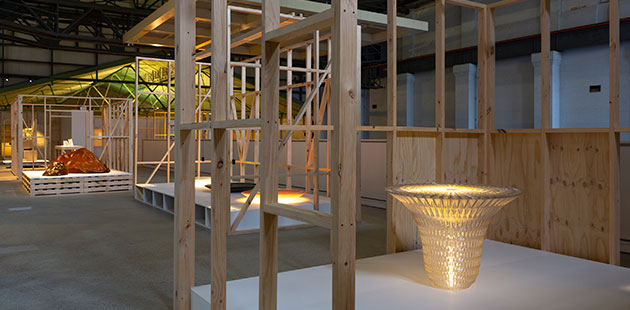 Interrogating the contemporary urban condition and exploring the role of the home in 2030, the Museum of Applied Arts & Sciences (MAAS) has unveiled Hybrid: Objects for Future Homes at the Powerhouse Museum from Saturday 12 September 2020.
Interrogating the contemporary urban condition and exploring the role of the home in 2030, the Museum of Applied Arts & Sciences (MAAS) has unveiled Hybrid: Objects for Future Homes at the Powerhouse Museum from Saturday 12 September 2020.
Hybrid is the latest exhibition to be presented at the museum showcasing new commissions from nine design studios responding to the pressing issues of our time and exploring the needs of the future home.
In collaboration with Creative Director and writer Stephen Todd, the Powerhouse has commissioned the design studios to work with researchers and practitioners from alternative industries to create a series of furniture and objects exploring the rapidly changing global landscape and responding to issues such as the COVID-19 global pandemic, air quality, bush fires, rising temperatures and wellbeing.
“The way we live and how we perceive and experience our homes is being radically altered,” says Todd. “The primary role of the home in the 21st century is to be a sanctuary, a respite from the clamour of daily life, the ultimate refuge in these times of crisis. For the Hybrid commission, we asked creatives outside of the field of design to create domestic artefacts for our future.”
Acclaimed designer Trent Jansen and Nyikina man and saddler, Johnny Nargoodah explore the environmental changes witnessed by Johnny and his community in Western Australia with a critical piece of design communicating the traditional laws pertaining to the land and commenting on the devastating effects of climate change.
Using large-scale 3D printing, Sydney-based industrial and fine furniture designer Adam Goodrum, in collaboration with Ella Williams and Tran Dang of the UTS Advanced Fabrication Lab present furniture made from recycled ocean plastic, placing environmental considerations at the heart of the design process.
Sydney-based product and furniture designer Henry Wilson and Melbourne-based artist Stanislava Pinchuk present a reinterpretation of the water feature, commenting on the impact of climate change on the urban ecosystem.
Industrial designer Charles Wilson in collaboration with Gaurav Giri & Bala Mulloth of Hava Inc seek to reinvent domestic air purifiers. Design Duo GibsonKarlo, in collaboration with Australian Research Council Laureate Professor Veena Sahajwalla, explore the concept of death and its implications for those left behind, with artefacts developed from the objects left by the deceased.
Amsterdam-based designers Rive Roshan, in collaboration with Emmaline Cox, Design Director of Axolotl, Sydney, respond to the global pandemic, natural disasters and lockdown, with a responsive light source that brings the experiences of nature into the home.
Industrial and furniture designer Tom Fereday in collaboration with Dr Thea Brejzek Professor of Spatial Theory at UTS propose a series of sustainable, inclusive and responsible domestic products that respond to the themes of privacy, isolation and the importance of human interaction in the time of widespread spatial distancing.
Sydney industrial designer Andrew Simpson and mechanical engineer Professor Tracie Barber present a contemporary home shrine, a space to refocus and de-stress. Designer Elliat Rich with neuroscientist Professor Joel Pearson and Canberra Glassworks redefine the domestic mirror, exploring the concept of intrinsic wellness.
“The global pandemic and resulting restrictions have compelled people around the world to spend more time than ever at home,” said Powerhouse Museum Chief Executive, Lisa Havilah. “How we view and interact with our homes has changed significantly as a result and this new exhibition explores what this means for us now and the future.”
Hybrid: Objects for Future Homes
Powerhouse Museum, 500 Harris Street, Ultimo (Sydney)
Exhibition: 12 September 2020 – 28 February 2021
Free entry – bookings essential
For more information, visit: www.maas.museum for details.
Image: Installation View of Hybrid – courtesy of Powerhouse Museum
